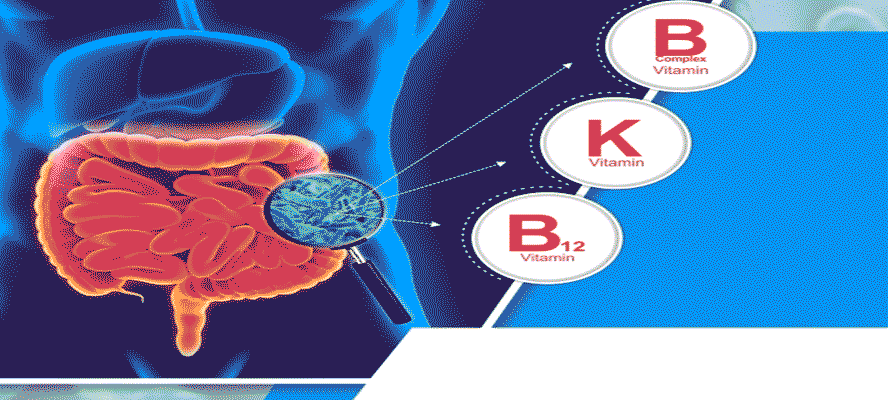Gut Microflora
The human gut is home to 10 microbial cells, constituting 300 to 500 different species of bacteria,
coexisting in a complex and dynamic ecosystem. Some of these bacterial species are pathogenic and
have the potential to cause infections or sepsis if the host immune system or barriers, are compromised.
Development of the microflora begins right from birth and the nature of the bacteria that colonizes the
gut depends upon the nature of delivery and the type of milk fed to the baby, This microflora differs in
infants than those of adults. The development into an adult-like profile occurs around one year of age,
when the baby is fed with solid food,
Among the bacterial species present, anaerobes outnumber aerobes and the most common species
found in the gut are Bacteroids, Bifidobacterium, Eubacterium, Escherichia, Enterobacter, Klebsiella,
etc. Bifidobacteria are among the first species to colonize the gut of newborns. Once the gut has been
colonized by the bacteria soon after birth, the overall composition of the microflora does not change by
much due to specific conditions of pH, intestinal motility, nutrients, host secretions, etc. Minor modifications
can arise due to dietary change or due to some conditions like diarrhea, old age, poor dietary habits,
stress or antibiotic treatment.
The relationship of mutual benefit between the host and bacteria is called commensalism. Gut
microflora have a variety of indispensable functions in our body, primary among these are the
synthesis of vitamins (mostly vitamin K), assisting the digestion of cellulose, as well as promoting
angiogenesis and enteric nerve function These bacteria benefit from this relationship as the host
provides the advantages of protection and nutrition.
Macronutrient metabolism
The great variety of gut bacteria becomes a source of a large number of different enzymes and Metabolic
pathways that can digest nondigestible components of the food. These microbial processes allow the
recovery of metabolic energy and substrates in forms that can be absorbed and utilized by the body.
Non-digestible carbohydrates such as polysaccharides, as well as some proteins and peptides are
converted into short-chain fatty acids. These short chain fatty acids have essential functions of their
own to play in our body, such as serving as energy source and modulation of glucose metabolism.
Mineral absorption
The fermentation of carbohydrates and production of short-chain fatty acids assists the absorption
of calcium, Magnesium and iron.
Cellular growth and differentiation
The resident, bacteria in gut greatly influence and stimulate the proliferation and differentiation of
the intestinal, epithelial cells.
Role in Immunity
The mucosa that lines the intestinal tract are a component of the immune system, as they serve as barriers
between the pathogen and host cells. They are also involved in the development of memory in the components
of immunity associated with systemic response to pathogens. Exposure to the antigens presented by these
bacteria primes the immune system into developing resistance against related pathogenic strains of bacteria
that may invade the body
Aside from these, gut microflora are also essential for one major function, that is
Vitamin Synthesis and Metabolism
Bacteroides, Bifidobacterium and Enterococcus are genera of bacteria that are known to synthesize vitamins,
including water-soluble vitamins like thiamine, folate, riboflavin and pantothenic acid. Of the fat-soluble
vitamins, nearly half of the daily requirement of vitamin Kis supplied by the gut bacteria.
Vitamin K
Vitamin K is a cofactor that is required for the synthesis of clotting factors II, VII, IX and X. In addition,
vitamin K is also necessary for improving bone health. It also reduces the risk of cardiovascular diseases.
The form of vitamin K known as menaquinone (vitamin K2) is suggested by some studies to be more effective
in these functions. Whereas dietary sources of vitamin K2 are limited, intestinal bacteria can serve as
alternative sources of the vitamin.
Intestinal bacteria produce menaquinone as a part of their electron transport chain, where it functions
as electron and proton carriers in the cytoplasmic membrane during respiration. In prokaryotic cells,
vitamin K2 is also proposed to have functions like antioxidant activity, cellular signaling, ATP synthesis,
nucleic acid synthesis, etc.
The production of vitamin K in the gut is done mostly by aerobic Gram positive bacteria and anaerobic
bacteria which use menaquinone in their electron transport chain. While originally it was thought that
gut bacteria contributed to 50% of total vitamin K requirement, the exact contribution is still uncertain
due to incomplete characterization of gut menaquinone content and the gut bacteria themselves. Further,
the route of absorption of menaquinones by the intestine is not clear, but appears to occur through a process
that requires bile salts in the small intestine. Majority of the production of menaquinone occurs in the colon,
where bile salts are present in reduced concentration. This might result in a lower absorption of vitamin K
by the intestine. This reduced absorption is essential, as
vitamin K is a fat soluble vitamins and complete absorption would result in circulatory concentrations
of vitamin K far exceeding the requirement of this vitamin. The composition of the gut bacteria also
influences the quantity as well as the forms of vitamin K that is produced; both of these also change
from person to person since the gut microflora composition is also different in different individuals.
Despite the low amounts of vitamin K produced by the gut bacteria, vitamin K is essential for maintaining
coagulation function in the body, especially among severely ill individuals who have suffered from vitamin
K deficiency over a long period of time. Also, presence of menaquinone has been demonstrated in the
hepatic tissues, indicating that vitamin K produced by the gut bacteria is not only bioavailable, but also
important as a source of micronutrients.
Vitamin B Complex
Vitamins of B complex serve as necessary cofactors for functions like fat and carbohydrate metabolism
and DNA synthesis pathways. Human cells are incapable of producing B complex vitamins in sufficient
amounts Moreover, being temperature sensitive and water soluble, these vitamins can be easily removed
or degraded, especially while cooking or due to prolonged storage. Hence, procurement of enough amount
requires synthesis by gut microflora. Colonocyte cells in humans exhibit the presence of receptors for B
complex vitamins, especially riboflavin, and therefore play a role in homeostasis of these vitamins. During
short periods of dietary vitamin shortage, these bacteria can provide sufficient B vitamins to avoid a deficiency.
These bacteria carry out the de novo synthesis of essential vitamins like biotin, cobalamine, Folate, nicotinic
acid, and other B complex that humans are incapable of producing.
Cobalamin (Vitamin B12) Synthesis
Produced exclusively by bacteria and Archaea, deficiency of this vitamin can result from either faulty
uptake due to disorders such as pernicious anemia, as well as inadequate intake through diet. Since
this vitamin cannot be produced by humans, it has to be obtained from microrganisms. Cobalamin is
produced in highest amounts in the colon, but its biovailability is linited due to the reduced number
of receptors required for absorbing the vitamin as found in the small intestine. Only some bacteria can
produce cobalamin; these include Pseudomonas denitrificans, Bacillus megaterium, and Propionibacterium
freudenreichii. It can be synthesized by two different mechanisms, by oxygen dependent pathway and
oxygen independent pathway.
Folic Acid (Vitamin B9) Synthesis
Folic acid is necessary for a variety of metabolic processes including synthesis of DNA and RNA.
Reduced forms of folate are used as one-carbon unit for synthesis of purines, pyrimidines, thymine
and methionine. As animals are incapable of producing these on their own, folate is obtained through
dietary sources as well as through intestinal bacteria. After synthesis, a carrier-mediated mechanism
found in the human colonocytes allows the contribution of folate obtained through intestinal bacteria
to host nutrition.
Lower levels of this vitamin are associated with coronary disease, as well as forms of anemia and
growth retardation. Folic acid is also protective against cancer. Lactobacilli that are obtained from
fermented foods are Gram positive eubacteria have been frequently investigated as sources of folate.
in addition to these, a large portion of the recommended pyridoxine intake and nearly a third of the
recommended folate and cobalamin is obtained through, intestinal bacteria.
Imbalances of Gut Microflora
In the event of abnormal changes in the gut ecosystem, the resident microflora can turn potentially
harmful, leading to allergies, Inflammatory Bowel Diseases (IBD), obesity, Diabetes, and possibly even
cancer. Certain bacteria like Escherichia coli (which can cause sepsis) and production of toxins by
Clostridium difficile can cause inflammation of the colon following a surgery or antibiotic treatment.
Other intestinal symptoms like bloating, abdominal pain and diarrhea are also seen in case of disturbance
in the composition of gut microflora. One of the most common manifestations of dysbiosis of gut microflora
is infections. When pathogens colonize intestinal mucosa, they cause an inflammation in that region.
Factors that influence gut microbiome:
1. Method of delivery at birth
2. Infant feeding
3. Genetics
4. Infections
5. Medications (especially antibiotic intake)
6. Diet
7. Environmental toxins
Diet and lifestyle have major effects on the quantity and composition of gut bacteria. Smoking, as well
as lack of exercise have significant impacts on the large intestine, and by extension, on the nature of
microbiota, which could even increase the risk of Crohn's disease. Toxin particles transmitted through
air due to increased environmental pollution can also contribute to imbalance in the microbiome,
manifesting as Irritable bowel syndrome (IBS). Higher levels of saturated fats stimulate the increase in
number of pro-inflammatory gut bacteria. Poor sanitary conditions, as well as impaired circadian cycle
can also alter gut microbiome.
The key here is to reduce the amount of saturated fats, sugary carbohydrates and increase the
consumption of probiotic foods like yogurt. Abstaining from alcohol and smoking, as well as sufficient
exercise can promote good gut health. After all, a happy gut translates into a happy life!





















































